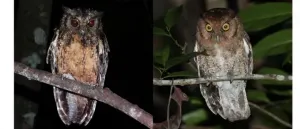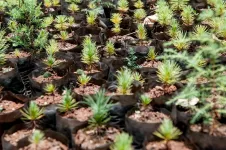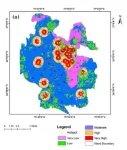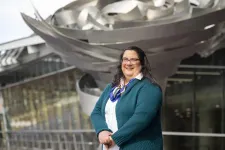(Press-News.org) A new study analyzes the larval dispersal of nine fish species in the western Mediterranean and identifies three large areas in which there is barely fish exchange, so fish would remain in the same area all their life.
The study, published in the journal Progress in Oceanography, is led by experts of the Faculty of Biology of the University of Barcelona and the Biodiversity Research Institute (IRBio) of the UB, the Blanes Center for Advanced Studies (CEAB-CSIC), the Balearic Islands Coastal Observing and Forecasting System (ICTS - SOCIB), and the Mediterranean Institute for Advanced Studies (IMEDEA, CSIC-UIB).
The three identified areas are the Balearic Sea, the West Algerian Basin, and the Alboran Sea. These marine areas are separated by oceanographic discontinuities that act as barriers, in this case the Ibiza channel and the Almeria-Oran front, two fronts that are hard to cross for fish larvae due to the difficult circulation and exchange of water masses.
These results are relevant for the setting of protecting areas since many of the demersal fish species -those living in seafloors- are sedentary in their adult life and barely move. However, when these are under the larval phase, they move across the currents mainly, a moment when they are more likely to distribute around outside their birth place.
Low Exchange between marine areas
The studied species are the common two-banded sea bream (Diplodus vulgaris), the white seabream (Diplodus sargus), the sheephead bream (Diplodus puntazzo), the dreamfish (Sarpa salpa), the saddle bream (Oblada melanuria), the damselfish (Chromis chromis), the Mediterranean rainbow wrasse (Coris julis), the ocellated wrasse (Symphodus ocellatus) and the East Atlantic peacock wrasse (Symphodus tinca). These species are abundant and present differences at a trophic level, the reproductive seasons and ways and the length of the larval phase (from 7 to 43 days and egg-laying in different seasons).
"Also, there is individualized information of these species on the birth date and larval life length according to a previous study", notes Hèctor Torrado, researcher at CEAB-CSIC and UB-IRBio, and lead author of the study. "This enabled the modelling of the dispersal at an individual level and to infer the potential origin of each individual", he adds.
"Our study shows that the three identified areas present a low exchange of individuals of all species and that should be considered three hydrodynamics units", notes Enrique Macpherson, researcher at CEAB-CSIC and co-author of the study. This information is relevant regarding the marine reserve setting.
Reserves must guarantee connectivity
In order for them to be effective, marine reserves should work as a network that allows an interconnection between them at a populational level. This enables a flux of species and individuals that ensure its efficiency in the conservation of marine ecosystems.
"Therefore, inside every hydrodynamic unit, there can be a good network of interconnected areas but this connection will be weak between units. This information has to be considered when designing a network of protected areas including different areas", notes Marta Pascual, lecturer at the Faculty of Biology and UB-IRBio and co-author of the study.
Most of the fish spend their life in the same oceanographic region where they were born. However, there are some exceptions. For instance, the Balearic Sea features individuals that were born in the same area but some could have arrived from the north, Provençal waters and the Ligurian Sea.
Experts also consider reproductive periods of species as an important factor (egg-laying, hatching period, and the length of the larval period). As the study states, there are seasonal changes in the oceanographic barriers that affect their permeability and as a result, the larval crossing across these barriers. Also, the speed and direction of currents can change over the year, which also affects the larval dispersal and connectivity between areas.
Moreover, there are areas with a higher variation, not only seasonal but also interannual, which can change connectivity between localities at an evolutionary scale.
The dynamics and seasonal variations of water masses can determine the connectivity patterns of these species, experts say. Regarding how much these results of nine species could be extrapolated to other species, scientists say that "in theory, most of coastal fish of western Mediterranean could be extrapolated since we see that the three hydrodynamic units are detected in different species that reproduced in different seasons and with a different larval life length".
"Nevertheless, at a small scale, we observe the importance of the birthdate in the origins of larvae that settle in a place, suggesting that both direction and distance are influenced by the oceanographical variables of the area", conclude the experts.
INFORMATION:
A new method makes it much easier to follow the progression of multiple myeloma, a form of blood cancer. With a single drop of blood, it is possible to very accurately show whether the number of cancerous cells in the bone marrow is increasing in a patient. In time, this blood test could potentially replace the current bone marrow puncture.
Researchers at Radboud university medical center, in collaboration with Erasmus MC, have taken an important step towards implementing this new diagnostic, with a study published in Clinical Chemistry. Multiple myeloma is a severe form ...
Perovskites, a class of materials first reported in the early 19th century, were "re-discovered" in 2009 as a possible candidate for power generation via their use in solar cells. Since then, they have taken the photovoltaic (PV) research community by storm, reaching new record efficiencies at an unprecedented pace. This improvement has been so rapid that by 2021, barely more than a decade of research later, they are already achieving performance similar to conventional silicon devices. What makes perovskites especially promising is the manner in which they can be created. Where silicon-based devices are heavy and require high temperatures for fabrication, perovskite devices can be lightweight and formed with minimal energy investiture. It is this combination - high performance ...
New study led by the University of Helsinki supports the recognition of new species of South American owls, two of them, Xingu Screech Owl and Alagoas Screech Owl, described for the first time.
In early 2021 two new species of screech owls are being described in a single publication as new to science. A multinational team involving researchers from the University of Helsinki, Brazil, and the USA published a detailed study focusing on the morphological, vocal, and genetic variation in a group of screech owls from the Amazon and Atlantic Forest regions of South America, called the Black-capped / Tawny- bellied Screech Owl complex (Megascops atricapilla - M. watsonii). The term "complex" describes ...
Every year, 10 million hectares of forest are lost. Among efforts to revive degraded or deforested land is the Bonn Challenge, with a global goal to bring into restoration 350 million hectares by 2030. Yet such efforts neglect the nuanced but critical factor of bringing genetic diversity into restoration efforts for long-term success, which urgently needs to be addressed.
Integrating genetic diversity involves planting tree species with different genetic makeups and varied species adapted to local environments. If species are the same, they will not be able to reproduce or grow new seedlings. Christopher Kettle, an ecologist and geneticist at the Alliance of Bioversity International and the ...
As COVID-19 vaccines slowly roll out across the world, government officials in densely populated countries must still manage vulnerable communities at highest risk of an outbreak.
In a new study published in the Journal Risk Analysis, researchers in India propose a COVID Risk Assessment and Mapping (CRAM) framework that results in a zoned map that officials can use to place more targeted restrictions on high-risk communities. Successfully used by officials in Jaipur at the peak of the pandemic last spring, their framework could help other vulnerable countries avoid a shutdown of their regional economies.
Led by Shruti Kanga, associate professor in the Centre for Climate Change and Water Research at Suresh ...
An estimated 6 million Americans may suffer from peanut allergies. Tiny amounts of peanut protein can lead to hives, itching, tingling in the mouth, shortness of breath or nausea within minutes.
For individuals with severe peanut allergies, food-induced anaphylaxis can occur. It's a life-threatening emergency that requires treatment with an injection of epinephrine and a trip to the emergency room. Food labels offer warnings such as "may contain peanuts" or "was processed in a facility that may process nuts."
The warnings allow individuals with severe reactions to steer clear, but for consumers who may be able to tolerate a minimal amount of peanut protein without major incident the labels aren't very useful, says Lynne Haber, PhD, ...
Women who suffer from vision, hearing or dual sensory loss are more than twice as likely to report depression and anxiety as men who experience the same issues, according to a new study by Anglia Ruskin University (ARU).
The research, which has been published in the International Journal of Geriatric Psychiatry, looked at survey data from more than 23,000 adults, where participants had self-reported whether they had suffered depression or anxiety, and also whether they experienced vision, hearing, or dual (both vision and hearing) sensory impairment.
Across the whole sample, the prevalence of depression ...
So far, there has been little research into supportive care needs in patients with newly diagnosed incurable cancer and as their disease progresses. That is why experts from the German Cancer Society's working group on palliative medicine, led by Professor Florian Lordick, Director of the University Cancer Center Leipzig (UCCL), surveyed 500 patients between the ages of 25 and 89. What made the project special was the fact that the patients were accompanied from the moment they were diagnosed and before receiving any treatment. Professor Lordick sums it up thus: "There is an urgent need for patients to have early access to supportive palliative ...
Usually, the different areas in the cerebrum take on a very specific function. For example, they process our movements or things we see or hear, i.e. direct physical information. However, some areas of the brain come into play when dealing with more advanced mental tasks. They process incoming information that has already been pre-processed and is thus already at an abstract level.
It was already known that the inferior parietal lobe (IPL) is one of these regions in the human brain. Nevertheless, it was unclear how this area is able to process such very different functions. In a large study, scientists from the Max Planck Institute for Human Cognitive and Brain Sciences (MPI CBS) in Leipzig and McGill ...
During a normal waking state, information is processed and shared by various parts within our brain to enable flexible responses to external stimuli. Researchers from the University of Turku, Finland, found that during hypnosis the brain shifted to a state where individual brain regions acted more independently of each other.
"In a normal waking state, different brain regions share information with each other, but during hypnosis this process is kind of fractured and the various brain regions are no longer similarly synchronised," describes researcher Henry Railo from the Department of Clinical Neurophysiology at the University of Turku.
The finding shows that the brain may function quite differently ...






